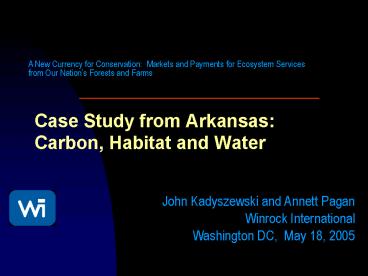Case Study from Arkansas: Carbon, Habitat and Water - PowerPoint PPT Presentation
1 / 27
Title: Case Study from Arkansas: Carbon, Habitat and Water
1
A New Currency for Conservation Markets and
Payments for Ecosystem Services from Our Nations
Forests and Farms
- Case Study from Arkansas Carbon, Habitat and
Water
John Kadyszewski and Annett Pagan Winrock
International Washington DC, May 18, 2005
2
Summary
- Arkansas Case Study
- Policy Considerations
- Emerging Sources of Potential Revenue
3
Remaining Forest -- 1992
Project Area
4
Arkansas Carbon Initiative
- Increase plant and animal biodiverstiy.
- Increase income on farms and in local
communities. - Sell carbon offsets to help fund the project.
5
Arkansas Carbon Initiative
- Objectives
- Develop a replicable model for using carbon
offsets to stimulate environmental restoration
and economic development at the farm and
community level - Develop a model for the sale, registration, and
verification of carbon offsets at the state and
national level - Develop markets for other environmental assets.
6
Arkansas Carbon Initiative
- Key steps
- Prove additionality
- Determine co-benefits
- Get start-up funds
- establish on-farm demonstration sites
- develop carbon monitoring protocols
- Attract buyers of carbon offsets
7
Collaborative Structure of Carbon Offset
Projects in Arkansas
RCD Project Coordination, Management Offset
Reporting
Project Funds Industry, Organizations,
Individuals
RCD, NRCS Coordination with farmers
communities
Winrock Planning, training and carbon measurements
8
Projects Carbon Equity Fund
- 100,000 from the WRF
- Have leased C offsets on 190 acres from two
landowners - Will hold offsets in reserve
- Leverage funds
9
Projects UtiliTree Carbon Company
- Planted hardwoods on about 400 acres of marginal
cropland - Will measure C over project lifetime
- Measured C in mature bottomland hardwood forest
10
Projects Entergy Carbon Offsets
- Planted hardwoods on about 600 acres of marginal
croplands - Will measure C over project lifetime
11
Enhance Local Incomes
12
Stackable Credits Carbon Water
13
Lessons Learned
- Build strong partnerships with local
organizations - Establish and maintain credibility with
investors, communities and landowners - Measurement
- Legal Framework
- Develop clear mechanisms for transferring carbon
offsets to investors and carbon revenue to
landowners. - GPS and GIS are powerful tools for identifying
project co-benefits and for registering carbon
offsets at local and national levels.
14
Carbon Measurement
15
Entergy
16
(No Transcript)
17
Quantifying Carbon Markets
18
Policy Considerations
- Role of government in creating markets
- Program structure
- Mandatory vs.voluntary
- Targeted vs. non-targeted
- Regional vs. local
- Accountability
19
Sources of Potential Revenue
- Carbon markets
- Energy markets for biomass fuels
- Water
- Trading to reduce sediment and nutrients
- Urban demand
- Certified wood
- Reduce fire risk -- hazardous fuel reduction
20
Look at Current Land Use Patterns to Determine
Existing Carbon Stocks and Potential for Change
21
Potential for Revenues from Energy Markets
Co-Firing Biomass with Coal
22
Carbon from Afforestation after 80 Years
23
Water Quality
24
Regional vs. Local
25
Forest Certification
26
(No Transcript)
27
John Kadyszewski
- (703) 525-9430, ext 618
- Jkadyszewski_at_winrock.org





















![Activated Carbon Market Size, Share & Growth [2016-2021] PowerPoint PPT Presentation](https://s3.amazonaws.com/images.powershow.com/9404136.th0.jpg?_=20200225035)









